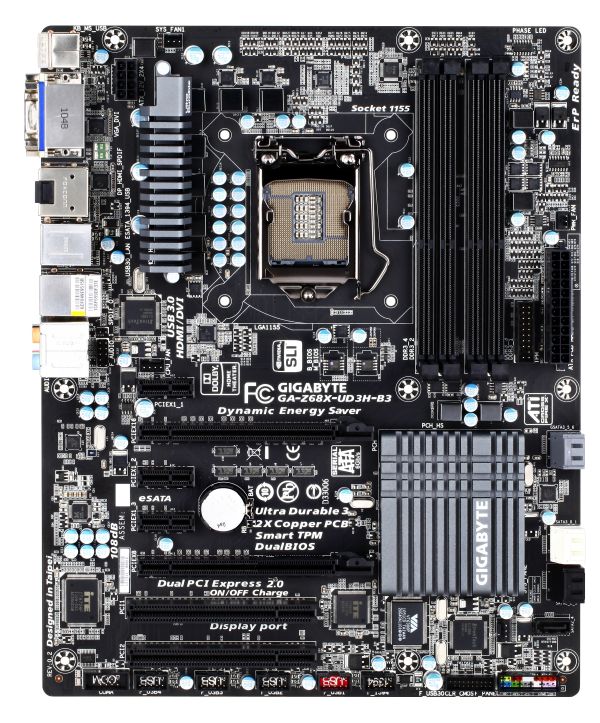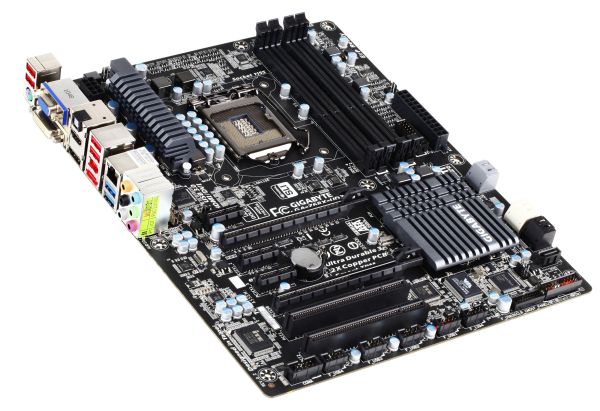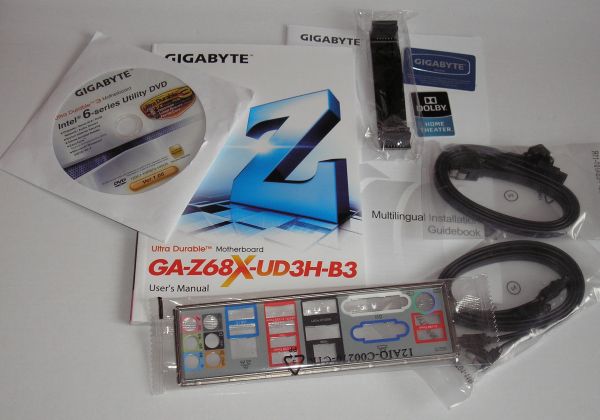Gigabyte Z68X-UD3H-B3 Review
by Brendan van Varik on July 11, 2011 7:01 AM EST- Posted in
- Gigabyte
- Motherboards
- Sandy Bridge
- Z68
Gigabyte has released their Z68 lineup, and today I am going to look at the UD3H - a $170 Z68 board aimed at the mainstream consumer market. The Z68 based motherboards are very similar to the P67 equivalent but they have had a few extra features added. They include Virtu and SSD caching as well as allowing you to take advantage of the GPU built into your Sandy Bridge processor. Is it worth switching from P67 to Z68 for a few extra features? Well, after what I have seen, no, not really.
Visual Inspection
Just like most of Gigabyte's latest range, they have gone with the black and gray theme for this motherboard. In my eyes, it looks very classy and professional.
Gigabyte engineers have used their heads when it comes to the PCIe layout. There’s plenty of room for dual GPU configurations and there’s even a slot for breathing space when utilizing dual slot GPUs. From top to bottom, we have a PCIe 1x, 16x, 1x, 1x, another 16x and two PCI slots. When two GPUs are used, the PCIe 16x lanes run at 8x/8x.
As the PCH heatsink is small and passive, so if dual GPUs are utilized, there may be a heat conductance issue on to the heatsink if there is a lack of airflow. Some aftermarket graphics card coolers vent hot air into the case which will also cause the PCH to warm up if the chassis isn’t vented properly. In fact, when the board was put through its paces on the test bed, the PCH heatsink got very warm to the touch if there was no fan pointed at it.
There is a regular looking I/O panel. The picture above details the selection of connectivity options at the back of this motherboard. A PS/2 port which can be used for either a keyboard or a mouse but not both at the same time. There are a total of four USB 2 and two USB 3 ports, an eSATA 3Gb/s port as well as a FireWire port. The display ports include DVI, VGA, HDMI and a display port. The HDMI and DisplayPort connections carry audio. The single Ethernet port is controlled by the Realtek RTL8111E chip. You can use either the SPDIF or the typical audio connections for your sound.
With regards to the SATA connections, we have three (internal) SATA 3Gb/s connections and four SATA 6Gb/s ports. There is an eSATA port on the I/O of the motherboard which takes the total of SATA 3Gb/s ports to four. Two of the four SATA 6Gb/s ports are controlled by a separate controller – a Marvell 88SE917. These are colored gray and have support for RAID 0 and 1. The rest of the SATA ports are controlled by the Intel Z68 chipset and allow for RAID 0, 1, 5 and 10. You are able to create a RAID array across the SATA 3Gb/s and 6Gb/s ports although the performance may vary (according to Gigabyte).
After comparing to other motherboards, the SATA layout is a tad odd. On most motherboards, you would typically find a row of SATA connectors that are adjacent to each other and then color-coded accordingly. Even though it is only one port which points out of the board and the rest stick out of the side, it looks odd and it doesn’t make sense why this has been done.
A total of four fan headers can be used on this motherboard. There is one for the CPU cooler and three for chassis fans. The CPU fan header is not located in a familiar position as you’d find with other motherboards - it’s in the center board just above the PCIe 1x slot. The two system fans are on opposite sides of the board - one is located just above the VRM heat sink and the other is located just below the PCH heat sink. It would have made more sense to use the header located above the VRM heat sink as the CPU header and vice versa. The PWR fan header is located just above the 24pin power which just like SYS_FAN1 does not allow for speed control.
What is included in the box?
A user’s manual and a multilingual guidebook.
- Driver and utilities DVD
- 2x SATA 6Gb/s cables
- 2x SATA 3Gb/s cables
- A SLi bridge
- I/O shield
- 1x Gigabyte case sticker
- 1x DOLBY case sticker
You do not get many extras with this motherboard. In fact, it is pretty minimalist. Just like other manufacturers, Gigabyte have included the essentials to get your system up and running, and nothing more. If you want more accessories such as the 3.5” front panel with two USB 3.0/2.0 ports or a SATA bracket, you will have to buy the more expensive, higher end models.















70 Comments
View All Comments
Taft12 - Monday, July 11, 2011 - link
Though your specific case leads a problem, I still think there are more PCI cards in use in the world's PC's than PCIe x1 cards. Also, why did you get a 3-slot GPU when you had 3 other expansion cards you wanted to use??Gigabyte DOES do the right thing by placing an x1 slot ABOVE the highest x16 slot. This should be standard practice on all motherboards and sadly it is not.
cyberguyz - Tuesday, July 12, 2011 - link
The point I was trying to make is that PCI cards are on the way out. They are obsolete. In order to implement them on the latest chipsets, the motherboard manufacturer actually has to include extra components to bridge the PCI slots to PCIe. Yes, there are still people using PCI cards - I agree, but that number is decreasing every year in favor of PCIe cards.As to why I am using a video card that uses 3 slots... I wanted a video card with very high performance that runs nice and cool. Simple. Very high performance video cards that run cool use coolers that take up 3 slots.
Yes, having that one slot above the PCIe x16 slot helps - as long as the PCIe card is small like a cheap network controller or 2-port SATA software raid controller. Some mobo makers put a BIG northbtridge heatsink just inboard of that 1x slot which blocks all but the shortest cards. I would not advise putting a Creative Labs Fatility Titanium pro soundcard there though. The metal shield gets awful close to the backside of the video card (granted would be a problem with any PC with loaded slots) and blocks airflow (video cards need airflow on the backside as well as the cooler side).
There are some motherboards that do away with the PCI slots altogether, but they suppliment the PCIe slots with a secondary PCIe controller/bridge (i.e. Maximus IV Extreme-Z), but you are going to pay dearly for that.
enterco - Monday, July 18, 2011 - link
@On-topic: I don't see any reference to the limitations of the Intel RST when used with RAID configurations. If anyone succeeds to enable SSD caching/acceleration of an array with two existing volumes, please let me know. I know that Intel RST 10.5 , combined with mixed configurations, such a 2 drives array with one striped volume and with a secondary mirrored volume aren't too popular, but this kind of configuration can't be accelerated with Z68's SSD caching combined with iRST ver. 10.5.@Cyberguyz: I see that you are trying to suggest toat PCI devices are obsolete.
Let me share some of my experience.
Chapter one: I've used a PCIe sound card: SB X-Fi Titanium Fatal1ty Pro until one of the SMDs burnt. After that event, the sound card wasn't able to use the analogic inputs/outputs and the driver provided by the vendor no longer installed properly. I believe that the burnt SMD was responsible with the power delivery to the analogue I/O part of the sound card.
Chapter two: I tought that 'using PCI Express' will 'bring me to today', so I bought an Asus Xonar D2X instead of an Asus Xonar D2/PM. I'think i've made a bad decision, and I'll explain why. The D2X has two things different from the D2/PM: it includes a PCI Express-to-PCI bridge [a supplemental component], and it needs to be powered by a molex/floppy connector.
So... why would anyone want to add latency to the audio system and take care of the extra power cable ? It may be useful ONLY IF the PCI variant, D2/PM can't fit into the computer.
When I bought my Asus sound card, I wanted something 'new', not the obsolete PCI version, but today I would choose the PCI version if I must buy a new sound card.
Chapter three. Recently, I was looking for a PCI Express USB3 controller. I wasn't able to find one without: a) a molex/floppy power connector; b) PCI Express X4 connector. I'm trying to show that the power provided by a PCI Express X1 is not always enough for some devices.
I think that the PCI slots are mature and powerful enough, even for today's standards, to be taken into consideration. A PCI Express X1 slot provides less power than a PCI slot, which may imply the need for an additional power connector to the card.
On the Intel 486 / Pentium days there was a sound card, the AWE32 and AWE64. None of them were PCI-based, even if PCI was mature at the time. The bandwidth provided by the ISA slots was enough for these cards.
Let's do some math. A sound card using 4 channels , 16 bit/sample at 44,1 kHz sampling rate requires approx. 3,4 Mbit/sec bandwidth. Multiplying the number of channels, the sampling rate and the bits per sample, to today's standards, a sound card does not need more than 70 Mbps bandwidth. A PCI bus, 33 bit, 33 MHz, can provide 1 Gbps bandwidth, meaning that a sound card at today's standards can use only 1/16 of the bandwidth of the PCI/32bit/33MHz bus.
just4U - Tuesday, July 12, 2011 - link
For me finding a PCle Sound card (locally) is a real pain. Atleast one I'd actually buy. PCI variants are around in abundance so there's still a call for it.DanNeely - Tuesday, July 12, 2011 - link
There's no single layout that will suit all GPU layouts; so it behooves you to pick a board with a good layout for what you want. With 3 slot GPUs being much rarer than 2 slot SLI configurations you can expect to remain on the short end of the stick for the number of suitable layouts.As for legacy PCI remaining on boards I don't expect to see it go away on full size ATX boards any time soon. With only 8 1x lanes available on the southbridge there isn't enough connectivity available to fill out all 5 slots and attach all the misc devices. Firewire, audio, non intel SATA, non intel nic (x2?), USB3 port pair (x2? x3?) all eat away at the SBs limited connectivity. If thunderbolt starts showing up in future systems it'll only make the connectivity situation worse.
A 1 PCIe to 4 PCI bridge chip brings the situation back to roughly what it was in the prior generation; FW, and audio fire easily on PCI . It's not quite as good as it was on last generation chipsets though since you only have 11 connections vs 13 (8 + 5); I suspect this may be behind the drop in the number of boards with an x4 slot. While they could use a 1:4 PCIe bridge instead, older PCI parts are probably cheaper and they don't want to lose out on sales to the minority with at least one PCI device they still need. Exposing those ports to end users could have issues as well since they could bottleneck at much lower system load levels than DMI would.
Unless Intel bumps the SB PCIe lane count to 12 (or goes PCIe 3.0 on the SB), goes all up SATA 3.0, and adds at least a half dozen USB3 ports (if not all up) to the next generation chipset I expect we'll see legacy PCI lanes on most of next years crop of boards as well.
PR3ACH3R - Monday, July 18, 2011 - link
What (could have been )an amusing comment,if it wasnt for the fact that no one on his right mind would put a GTX 570 on any machine he cares about a High end Pcie sound card.
not to mention total disregard of the simple (& obvious) fact that most professionals/users if theyr'e at all using an expensive pro card, 80% of it is PCI.
But hey you have a point, they should have consulted you, not the market analysts.
poohbear - Monday, July 11, 2011 - link
totally blows about the bios' lack of graphical layout. The asus boards are so convenient for having the newer bios' and i feel like im in 2011. These old bios' screens belong to the 90's that everyone still uses..:pMr Perfect - Monday, July 11, 2011 - link
I would agree. I'd pass up this board on that fact alone. Everyone else has their act together when it comes to a UEFI interface, what the major malfunction here? Not acceptable from a tier one board manufacturer.Taft12 - Monday, July 11, 2011 - link
I dunno guys, if you can't handle a keyboard-only interface, you should hand in your geek-cred cards now. This is Anandtech after all!cyberguyz - Tuesday, July 12, 2011 - link
Y'know - the UEFI in those others do have an advanced mode that does all the same things as the old char mode bios. I kinda like the bootup UEFI and really don't want to dual-boot Windows on my Linux box just to fart around with a graphical bios (and yes, I have been working with character mode bios as long as character mode bios have existed - my earliest adventures with overclocking was with jumper caps on a 486 board ;D ).But to each their own.